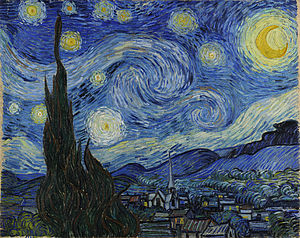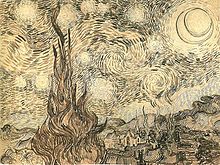- The Starry Night
-
The Starry Night 
Artist Vincent van Gogh Year 1889 Type Oil on canvas Dimensions 73.7 cm × 92.1 cm (29 in × 36¼ in) Location Museum of Modern Art. Acquired through the Lillie P. Bliss Bequest, New York City The Starry Night (Dutch: De sterrennacht) is a painting by Dutch post-impressionist artist Vincent van Gogh. The painting depicts the view outside his sanitarium room window at night, although it was painted from memory during the day. Since 1941 it has been in the permanent collection of the Museum of Modern Art in New York City. Reproduced often, the painting is widely hailed as his magnum opus.
Contents
Genesis
In September 1888, while van Gogh was staying in Arles, he executed a painting commonly known as Starry Night Over the Rhone[1] and later he incorporated a pen drawing in a set of a dozen based on recent paintings. Van Gogh claimed to have a "terrible need for religion" when he painted Starry Night Over the Rhone.[2]
In mid-September 1889, following a heavy crisis which lasted from mid-July to the last days of August, he thought to include this "Study of the Night"[3] in the next batch of works to be sent to his brother, Theo, in Paris. In order to reduce the shipping costs, he withheld three of the studies ("above-mentioned – Poppies – Night Effect – Moonrise"). These three went to Paris with the shipment to follow.[4] When Theo did not immediately report its arrival, Vincent inquired again [5] and finally received Theo's commentary on his recent work.[6]
Subject matter
The center part shows the village of Saint-Rémy under a swirling sky, in a view from the asylum towards north. The Alpilles far to the right fit to this view, but there is little rapport of the actual scene with the intermediary hills which seem to be derived from a different part of the surroundings, south of the asylum. The cypress tree to the left was added into the composition.[7] Of note is the fact van Gogh had already, during his time in Arles, repositioned Ursa Major from the north to the south in his painting Starry Night Over the Rhone.
Recent commentaries
- Simon Singh, in his book Big Bang, says that The Starry Night has striking similarities to a sketch of the Whirlpool Galaxy, drawn by Lord Rosse 44 years before van Gogh's work.
- The painting has been compared to an astronomical photograph of a star named V838 Monocerotis, taken by the Hubble in 2004.[8] The clouds of gas surrounding the star resemble the swirling patterns van Gogh used in this painting.
- Art historian Joachim Pissarro cites The Starry Night as an exemplar of the artist's fascination with the nocturnal.[9]
Aims and ends
Van Gogh was not so happy with the painting. In a letter[3] to Theo from Saint-Rémy he wrote:
“ The first four canvases are studies without the effect of a whole that the others have . . . The olives with white clouds and background of mountains, also the moonrise and the night effect, these are exaggerations from the point of view of arrangement, their lines are warped as that of old wood. ” Later in this letter, Vincent referred once more to the painting:
“ In all this batch I think nothing at all good save the field of wheat, the mountain, the orchard, the olives with the blue hills and the portrait and the entrance to the Quarry, and the rest says nothing to me, because it lacks individual intention and feeling in the lines. Where these lines are close and deliberate it begins to be a picture, even if it is exaggerated. That is a little what Bernard and Gauguin feel, they do not ask the correct shape of a tree at all, but they insist absolutely that one can say if the shape is round or square - and my word, they are right, exasperated as they are by certain people's photographic and empty perfection. Certainly they will not ask the correct tone of the mountains, but they will say: In the Name of God, the mountains were blue, were they? Then chuck on some blue and don't go telling me that it was a blue rather like this or that, it was blue, wasn't it? Good - make them blue and it's enough! Gauguin is sometimes like a genius when he explains this, but as for the genius Gauguin has, he is very timid about showing it, and it is touching the way he likes to say something really useful to the young. How strange he is all the same. ” Notes
- ^ Webexhibits.org, 595
- ^ Dietrich Blumer, M.D. The Illness of Vincent van Gogh Am J Psychiatry 159:519-526, April 2002.
- ^ a b Letter Webexhibits.org, 607
- ^ Letter Webexhibits.org, 608
- ^ Letter 609
- ^ Letter Webexhibits.org, T19
- ^ MOMA.org The Museum of Modern Art maintains the traditional identification of a cypress tree.
- ^ Hubble/ESA photo release
- ^ Nytimes.com, Darkness Was Muse for a Master of Light
References
- Boime, Albert: Vincent van Gogh: Starry Night. A history of matter, a matter of history (also available on CD-ROM: ISBN 3-634-23015-0 (German version))
External links
- The Starry Night at the Museum of Modern Art
- The Starry Night on Google Art Project
- smARThistory: van Gogh's Starry Night
- Multimedia study of van Gogh, McLean and Sexton
- On Exhibit at the Van Gogh Museum in Amsterdam February 13-June 7 2009, retrieved January 31, 2009
- The Starry Night at the Most Famous Paintings
Vincent van Gogh General Biography · Chronology · Health · Death · Posthumous fame · Cultural depictions · List of works · Post-Impressionism · Auberge Ravoux
Family Theo van Gogh · Wil van Gogh · Johanna van Gogh-Bonger · Andries Bonger · Theo van Gogh (film director) · Anton Mauve · Johannes StrickerFriends Groups of works Self-portraits · Portraits · Early works · Lost early works · Sien · Peasant Character Studies · Cottages · Van Gogh's family in his art · Montmartre · Le Moulin de la Galette · Asnières · Seine · Wheat Fields · Flowering Orchards · Almond Blossoms · Langlois Bridge at Arles · Paintings of Children · The Décoration for the Yellow House · The Roulin Family · Hospital in Arles · Butterflies · Saint-Paul Asylum, Saint-Rémy · The Enclosed Wheat Field at Saint-Rémy · Copies by Vincent van Gogh · Olive Trees · Display at Les XX, 1890 · Auvers size 30 canvases · Auvers Double-squares and Squares · Japonaiserie · Sunflowers · Still life paintings by Vincent van Gogh (Netherlands) · Still life paintings by Vincent van Gogh (Paris)Paintings The Potato Eaters · Sunflowers · The Night Café · Poppy Flowers · The Yellow House · Cafe Terrace at Night · Starry Night Over the Rhone · The Bedroom · L'Arlésienne · The Red Vineyard · Les Arènes · View of Arles, Flowering Orchards · Arles: View from the Wheat Fields · Portrait of the Artist's Mother · Ivy · Farmhouse in Provence · The Starry Night · At Eternity's Gate · Irises · Portrait of Dr. Gachet · Doctor Gachet's Garden in Auvers · The Church at Auvers · Wheatfield with Crows · View of Paris from Vincent's Room in the Rue Lepic · Daubigny's Garden · Agostina Segatori Sitting in the Café du Tambourin · Portrait of Père Tanguy · Thatched Cottages by a Hill · White House at Night · Poppy Flowers · A Lane near Arles (Landscape with Edge of a Road) · Blossoming Chestnut Branches · A Meadow in the Mountains: Le Mas de Saint-PaulOther works Public collections Portrayals Lust for Life (novel)/(film) · Van Gogh (1991 film) · Van Gogh (1948 film) · Vincent · Vincent & Theo · Vincent in Brixton · "Vincent and the Doctor"Wikimedia Categories:- 1889 paintings
- Paintings of the Museum of Modern Art
- Vincent van Gogh paintings
- Vincent van Gogh paintings of Saint-Rémy
Wikimedia Foundation. 2010.


